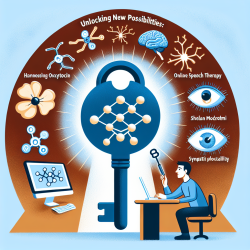Introduction
The prevalence of sexual violence (SV) and adolescent relationship abuse (ARA) is a pressing concern globally, with significant implications for public health. The study "Engendering Healthy Masculinities to Prevent Sexual Violence: Rationale for and Design of the Manhood 2.0 Trial" offers a comprehensive approach to addressing these issues by focusing on gender norms and bystander intervention. This blog explores how practitioners can leverage the findings of this study to enhance their skills and improve outcomes for adolescents.
Understanding the Manhood 2.0 Trial
The Manhood 2.0 trial is a gender-transformative program aimed at adolescent males aged 13-19, conducted in Pittsburgh's lower-resource neighborhoods. The program challenges harmful gender and sexuality norms that contribute to SV and ARA, while promoting bystander intervention skills. The study employs a community-based cluster-randomized trial design, comparing the effectiveness of Manhood 2.0 with a job readiness training program.
Key Findings and Implications for Practitioners
The Manhood 2.0 trial highlights several critical outcomes that practitioners can integrate into their work:
- Gender Norms Change: The program effectively shifts attitudes towards more equitable gender norms, which is crucial in reducing SV/ARA perpetration.
- Bystander Intervention Skills: Training adolescents in bystander intervention can empower them to interrupt disrespectful and harmful behaviors among peers.
- Healthy Sexuality Education: Educating young males about healthy sexuality, consent, and sexual coercion is vital in promoting respectful sexual behaviors.
Applying the Research to Practice
Practitioners can apply the insights from the Manhood 2.0 trial in various ways:
- Curriculum Development: Integrate gender norms and bystander intervention components into existing educational programs.
- Community Engagement: Collaborate with community organizations to deliver programs in informal settings, allowing for deeper discussions and engagement.
- Professional Development: Train facilitators and educators in gender-transformative approaches and bystander intervention strategies.
Encouraging Further Research
While the Manhood 2.0 trial provides valuable insights, further research is necessary to explore the long-term impacts of gender-transformative programs. Practitioners are encouraged to participate in or conduct studies that assess the effectiveness of similar interventions in diverse settings.
Conclusion
The Manhood 2.0 trial offers a promising approach to preventing SV and ARA by addressing gender norms and empowering adolescents with bystander intervention skills. By integrating these findings into practice, practitioners can contribute to creating safer and more equitable environments for young people.
To read the original research paper, please follow this link: Engendering healthy masculinities to prevent sexual violence: Rationale for and design of the Manhood 2.0 trial.










